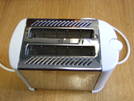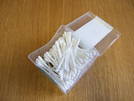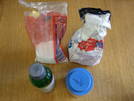Secret messages - what makes an Invisible Ink?
Ingredients
 | Some paper |  | A toaster |
 | Cotton buds or a paint brush |  | Various kitchen materials such as fruit juice, sugar, salt, bicarbonate of soda etc. |
Instructions
If any of your materials are not liquid, then try dissolve them in water.
 Using a cotton bud write on your paper using each of your invisible inks. If you're trying out lots of different inks, you may want to make a note in a normal visible ink which one is which, or you may loose the writing when the ink becomes invisible!
Using a cotton bud write on your paper using each of your invisible inks. If you're trying out lots of different inks, you may want to make a note in a normal visible ink which one is which, or you may loose the writing when the ink becomes invisible!
Allow the paper to dry out.
How invisible is your ink?
Now you should try developing the ink, to do this turn on your toaster, and hold the paper over the top until the paper starts to brown or you can read your message.
Which of your inks work?
Be careful, a toaster is hot, so don't touch the toaster or the paper while it's over it. Also don't put the paper inside the toaster as it is possible it may catch fire.
Result
You should find that many of the inks will develop as you heat them up, and your message should become visible. Some chemicals will make better inks than others,and may develop at different rates.
We have found that all fruit juices will work well, but some are more invisible than others in the first place. Dissolved sugar or bicarbonate of soda make particularly good invisible inks. Rather surprisingly we found that dissolved salt and even tap water worked here in Cambridge.
Explanation
As you may have noticed there are a huge range of different substances which work well as invisible inks...
Sugars
If you heat up sugar to a high enough temperature the sugar molecules react with one another to form long chains. These chains tangle with one another making the result much thicker and more viscous as it turns into caramel or even toffee. The other effect is that the chains start to absorb blue light and then as they get longer some green light too. This means they have a brown colour, so as you heat the sugar you are forming writing made of toffee which you can actually smell!
Fruit juices
The sugars in fruit juices will undergo some caramelisation, just as with sugar alone, but they also contain proteins. When you heat up a mixture of proteins and sugars they undergo a series of chemical reactions called Mailliard reactions, attaching sugar molecules to protein molecules. This produces the tasty browning effect when you fry meat or onions, and adds to the browning on your message.
Bicarbonate of soda
The bicarbonate of soda solution is an alkali and will become a stronger alkali as you heat it because it forms sodium carbonate, but this is still white. Paper on its own will go brown if you heat it up to a high enough temperature, and this process seems to be assisted by the alkali, making the 'inked' paper brown at a slightly lower temperature.
Water
We even got a result from tap water, just before the paper browned on its own. It was mainly visible on the edges of the writing. This is probably because Cambridge is built over chalk, and our water comes from inside this chalk. Chalk is Calcium Carbonate, another alkali, so tap water here is a very weak alkali. This probably just pushes the browning temperature of the paper slightly lower and you can make out the writing. If you live in a soft water area, please try it and let us know what happens!
Salt Water
We saw a similar result with salt water to our surprising water result. Salt, Sodium Chloride, is a very unreactive chemical but again, the very edges of the lettering browned slightly before the rest of the paper. As this seemed to be behaving in the same way as the water, making a very small difference to the browning rate of the paper, the presence of salt may have had nothing to do with it!
- Previous Settling snow
- Next Microwaving Ice - why defrosting is so slow.










Comments
Add a comment